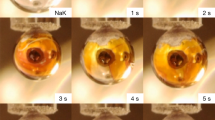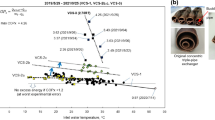Abstract
THERE is a possibility of explosions under a wide variety of conditions1–6 when liquids are rapidly mixed. When molten tin is poured from a crucible into water in defined conditions, a rapid explosive interaction takes place producing a sponge-like mass of debris7–9. We have repeated these experiments using an apparatus which provides small (∼ 0.25 g) and reproducible single drops of molten tin, and have been able to determine quantitatively the dynamics of the interaction by a photographic technique. Using a metal temperature of ∼ 570 K and water at room temperature metal drops were produced which entered the water in a straight vertical line but were then observed to deviate suddenly and sharply from their course without losing their pear-like shape. This metal temperature was just below that necessary to produce explosive interactions for the given water temperature.
This is a preview of subscription content, access via your institution
Access options
Subscribe to this journal
Receive 51 print issues and online access
$199.00 per year
only $3.90 per issue
Buy this article
- Purchase on Springer Link
- Instant access to full article PDF
Prices may be subject to local taxes which are calculated during checkout
Similar content being viewed by others
References
Long, G., Metal Progr., 71, 107–112 (1957).
Lipset, S. G., Fire Technol., 2, (2), 118–126 (1966).
Genco, J. M., and Lemmon, A. W., Trans. Am. Foundrymen's Soc., 78, 317–323 (1970).
Bradley, R. H., and Witte, L. C., Nucl. Sci. Eng., 48, 387–396 (1972).
Epstein, L. F., J. Nucl. Energy, Part B Reactor Technol., 3, 273–295 (1962).
Brauer, F. E., et al., Nucl. Sci. Eng., 31, 551–554 (1967).
Buchanan, D. J., and Dullforce, T. A., Nature phys. Sci., 245, 32 (1973).
Buchanan, D. J., J. Phys. D., Appl. Phys., 7, 1441 (1974).
Board, S. J., Farmer, C. L., and Poole, D. H., Int. J. Heat Mass Transfer, 17, 331–339 (1974).
Plesset, M. S., and Chapman, R. B., J. Fluid Mech., 47, 283–290 (1971).
Stevens, J. W., and Witte, L. C., Int. J. Heat Mass Transfer, 16, 669–678 (1973).
Author information
Authors and Affiliations
Rights and permissions
About this article
Cite this article
KONURAY, M., MEAD, H. & PAGE, F. Fall of liquid metal into water. Nature 254, 321–322 (1975). https://doi.org/10.1038/254321a0
Received:
Issue Date:
DOI: https://doi.org/10.1038/254321a0
Comments
By submitting a comment you agree to abide by our Terms and Community Guidelines. If you find something abusive or that does not comply with our terms or guidelines please flag it as inappropriate.



